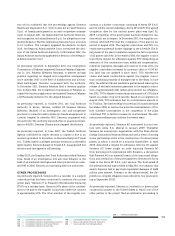Siemens 2012 Annual Report Download - page 294
Download and view the complete annual report
Please find page 294 of the 2012 Siemens annual report below. You can navigate through the pages in the report by either clicking on the pages listed below, or by using the keyword search tool below to find specific information within the annual report.
1 A. To our Shareholders 49 C. Combined Management Report 21 B. Corporate Governance
Siemens has established a foreign currency exchange rate risk
management system that has an established track record for
years. Each Siemens unit is responsible for recording, assessing,
monitoring, reporting and hedging its foreign currency transac-
tion exposure. The binding guideline for Siemens’ Divisions and
entities provides the concept for the identification and determi-
nation of a single net foreign currency position for each unit
and commits the units to hedge this aggregated position within
a narrow band of at least % but no more than % of their
net foreign currency position. In addition, the guideline pro-
vides a framework of the organizational structure necessary for
foreign currency exchange rate risk management, proposes
hedging strategies and defines the hedging instruments avail-
able to the entities: foreign currency exchange contracts, for-
eign currency put and call options and stop-loss orders. If there
are no conflicting country specific regulations, hedging activi-
ties of the operating units are transacted internally with Corpo-
rate Treasury. Hedging transactions with external counterpar-
ties in the global financial markets are carried out under these
limitations by Corporate Treasury. This includes hedging instru-
ments which qualify for hedge accounting.
Siemens has a Company-wide portfolio approach which gener-
ates a benefit from any potential off-set of divergent cash flows
in the same currency, as well as optimized transaction costs.
For additional information regarding the effect of this Compa-
ny-wide portfolio approach on the Consolidated Financial
Statements, as well as for a discussion of hedging activities
employed to mitigate or eliminate foreign currency exchange
rate risks see
.
The VaR relating to foreign currency exchange rates is calculat-
ed by aggregating the net foreign currency positions after
hedging of the entities. As of September , the foreign
currency exchange rate risk based on historical volatilities and
correlations, a ten day holding period and a confidence level of
.% resulted in a VaR of € million compared to a VaR of €
million in the year before. Changes in euro values of future
cash flows denominated in foreign currency due to volatile for-
eign currency exchange rates might influence the unhedged
portion of revenues, but would also affect the unhedged por-
tion of cost of materials. Future changes in the foreign currency
exchange rates can impact sales prices and may lead to margin
changes, the extent of which is determined by the matching of
foreign currency revenues and expenses.
Siemens defines foreign currency exchange rate exposure gen-
erally as items of the Consolidated Statement of Financial Posi-
tion in addition to firm commitments which are denominated
in foreign currencies, as well as foreign currency denominated
cash inflows and cash outflows from forecast transactions for
the following three months. This foreign currency exchange
rate exposure is determined based on the respective function-
al currencies of the exposed Siemens’ entities.
Effects of foreign currency translation
Many Siemens subsidiaries are located outside the eurozone.
Since the financial reporting currency of Siemens is the euro,
the financial statements of these subsidiaries are translated in-
to euro for the preparation of the Consolidated Financial State-
ments of Siemens. To consider the effects of foreign currency
translation in the risk management, the general assumption is
that investments in foreign-based operations are permanent
and that reinvestment is continuous. Effects from foreign cur-
rency exchange rate fluctuations on the translation of net as-
set amounts into euro are reflected in the Company ’s consoli-
dated equity position.
Siemens’ key consideration with respect to the interest rate risk
management is to mitigate the risk resulting from changes in
the fair value of future cash flows. Risk arises whenever inter-
est terms of financial assets and liabilities are different.
Siemens manages this risk using derivative financial instru-
ments which allow the Company to hedge fair value changes
by swapping fixed rates of interest into variable rates of inter-
est. In order to optimize the Company ’s position with regard to
interest income and interest expenses and to manage the over-
all financial interest rate risk with respect to valuation risk af-
fecting profit and loss and economic risk of changing interest
rates, Corporate Treasury performs a comprehensive corporate
interest rate risk management, under which the interest rate
risk relating to the SFS business and to the remaining group are
managed separately. For additional information see
.
If there are no conflicting country-specific regulations, all
Siemens segments and entities generally obtain any required
financing through Corporate Treasury in the form of loans or
intercompany clearing accounts. The same concept is adopted
for deposits of cash generated by the units.
Assuming historical volatilities and correlations, a ten day
holding period and a confidence level of .% the interest
rate VaR was € million as of September , , increasing
from the comparable value of € million as of September ,
. This interest rate risk results primarily from euro and U.S.
Dollar denominated long-term fixed rate debt obligations and
interest-bearing investments. The increase in VaR related
























